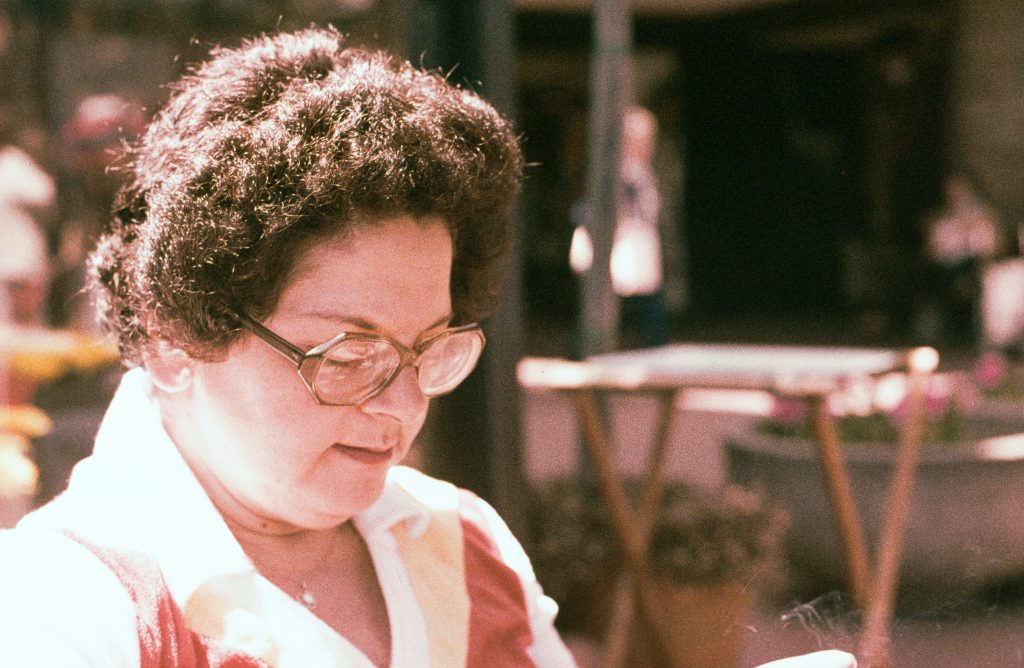Received word from some of my old friends from the program I attended in 1973 in Arad, Israel that we are going to attempt a class reunion. They asked for an update on what we’ve done since graduating. This will likely be repetitive for many of my friends and family, but here goes…
The reason I enrolled in WUJS was that I had been accepted to Graduate School in History at Tel Aviv University, but at that point knew only the Hebrew that was taught in two semesters at my undergrad institution, the University of Wisconsin (Madison). It was a terrific way to build my Hebrew and also participate in a program designed to introduce college graduates to the entire country. Almost a half century later I still treasure the memories of our visits from Rosh HaNikra in the far north to Beersheva and the agricultural settlements south of Arad.
The indelible memory of that year was seared in place by a major conflict known to most people as the Yom Kippur War which effectively ended WUJS instruction for me. Despite offers of repatriation from the US embassy, along with many others in WUJS, I signed up to do what I could. It wasn’t much–one of my memories from that experience was a kibbutznik too old to bear arms who would lean over and tell me in the dining hall, “You eat more than you’re worth.” And friends, I was skinny in those days!
When the war ended, some students remained at WUJS, but it was time for me to begin my studies at Tel Aviv U. My favorite class was elementary Latin (“You mean you want to study ancient history, but you have no Latin?!”). We were the first class at Tel Aviv U. which enjoyed learning Latin via a textbook written in Hebrew. Before that, students had to use a teaching book written in English. Lucky me! But really, it was a huge boost in my Hebrew comprehension.
At the end of that school year, I accepted an offer from the U of California (Berkeley) and began studying for an M.A. in Near Eastern Studies in the Fall of 1974. I completed that degree in December, 1976 and received “permission to proceed” to the Ph.D. But first, I felt that I still needed more coursework, and there was nothing left to take, so I applied to and was accepted as graduate fellow at Hebrew University of Jerusalem beginning in the Fall of 1977.
That academic year, Anwar Sadat stunned the world by coming to Jerusalem. I sometimes quip that my two years in Israel were, “War and Peace.”
I took as many course as I could at Hebrew U, and then it was time to return to the States. But my graduate advisor at Berkeley told me that given that only 4 PhDs in History at UCB had managed to find positions, I ought to consider other alternatives. So I applied to the Rabbinical program at HUC – Cincinnati. Oddly enough, they advised me to join the History PhD program there because I would receive a much better fellowship that way. And so I went from Jerusalem to Cincinnati. The most important scholar there for my interests was Samuel Sandmel. When I got to Cincinnati, I was his only student. During the semester he informed me that he had accepted a position at the U of Chicago and asked me to consider joining him. But the chancellor pulled me aside and cautioned me that Sandmel might not be alive much longer, so I declined his offer and indeed he passed away in February having made the move to Chicago just a month before.
Without Sandmel, staying in Cincinnati didn’t seem worthwhile although I did very much enjoy my studies in Talmud with Ben Zion Wacholder. Life intervened and I received word that my mother was in dire straits and needed my help. So I returned to Berkeley, made arrangements to settle my life down a bit, and then went to New York City to see how I might help my mother. She had had a severe episode of her long standing bipolar disorder and as a result lost her job. She was in danger of running out of money for the rent. My father, her husband, had abandoned us years before–ironically perhaps to move to Israel. I was an only child to her (my sister was born to a different mother) so it was me or no one. I packed her up and took her to California.
Continuing with the PhD program was now out of the question. I took a job as the Assistant Director of the Berkeley Hillel Foundation which involved leading religious services, teaching Hebrew courses and running the rather extensive Hebrew language program of the Lehrhaus Judaica which was co-housed in the Hillel building, and being responsible for the financial part of the foundation. To do that effectively I enrolled in Accounting classes at a local community college.
This was supposed to be a stop-gap until I got my mother settled, but we all know how that goes. I enjoyed my job, I enjoyed having the stability of a real income. In 1979 I purchased my first house in Oakland with the help of the Lehrhaus director. A couple of years later I met the woman who would become my wife of now 36 years.
We sold that first house to buy a house in Berkeley (this time together with our Hillel office manager who went on to be the leader of the Unitarian Universalists west of the Mississippi). And 1985 saw the birth of our first child, Shoshana. In 1987 the University of Michigan offered Terri a tenured position in their Psychology Department, and as much as I loved our lives in the fabled San Francisco Bay Area, we both agreed that moving to Ann Arbor was the sensible thing to do. So in 1988, Terri’s mom came out and helped Terri, Shoshana and our pet rabbits move to Michigan. I came a couple of months later with our dog. And a couple of months after that I moved Momma to Michigan.
Of course I was hoping for a job teaching Hebrew, but Hillel was staffed up and my mere M.A. wasn’t good enough for the U, so I was unemployed for awhile. I had learned a considerable amount about both accounting and database management, and a friend mailed me–quite out of the blue–a T-Shirt emblazoned with the word “Oracle.” One day, I felt a tap on my shoulder as I was picking Sho up from day care, and the father of one of the other kids asked me, “Do you know anything about Oracle?” I replied that “Yes, I had successfully deployed an Oracle database at my former employer in California.” He hired me on the spot to do a training session for his group at the University’s IT department because they had just paid $600k to license Oracle, but no one knew how to use it. After the session, he hired me as an external consultant to help them design databases, and after three years of that they decided it would be cheaper just to give me a job. That’s how I became an employee of the U of Michigan in 1992. In 1995 Ephraim joined our family, and shortly thereafter the College of Engineering hired me away from the IT department. I rose through those ranks and eventually was leading three departments within the College.
I decided to retire from the University when I turned 58 because I was qualified for benefits, they were running an early retirement program, my investments had done well, and really, I didn’t need the headaches any longer. I accepted a voluntary position as the first Executive Director (unpaid) of the County’s NAMI program.
2011 was a momentous year for our family. Ephraim had decided to make aliyah and complete his education in Israel. My mother sadly left us that year. And Terri received an offer to become the Dean of Arts and Sciences at the U of Tennessee, Knoxville. After a visit to check it out, we decided to take the offer. We sold our Ann Arbor house at which point Ephraim changed his mind and decided he would stay in Ann Arbor, but we held to our plan and we went to Knoxville while he remained in Ann Arbor.
A few months after our arrival, the Religious Studies Department was notified that faculty members they had hired to teach Hebrew had elected not to come and the director of Judaic Studies and the Head of the Religious Studies department asked me if would teach Biblical Hebrew for the year. And after that first year, they have hired me ever since, seven years now.
Of course they really wanted me to have a PhD, so I was approached by someone who offered to be my mentor for completing that project. She averred that given all my prior course work, it would probably only take me a year to start writing my dissertation. But the Grad School had other ideas about whether they were going to accept decades-old courses. I stuck with it and earned my PhD in History in December 2019.
Our daughter Shoshana now lives in Albuquerque, NM with her husband Karl and our two grandchildren, Clara and Alexander. My son Ephraim joined us in Knoxville after completing his BA at U of Michigan. He’s now in the later stages of a PhD in social geography and spatial statistics, and he is engaged to a woman who is also working on a PhD in the biological sciences.
That’s my story, and I’m sticking to it.
Added 4/13/20:
My father was a child of the beginning of the Soviet Union, his father was a highly educated Orthodox Jew (musmah Kishinev). My grandfather came to the States first and established a business selling second hand steel in Cleveland, OH. Then he was busted for selling stolen property and after spending everything to avoid jail moved to Detroit. Meanwhile, my great-grandfather, my grandmother’s father, found the cash to ship my Bubby and her three surviving children (three others seem to have died of Tay-Sachs) to Detroit. It’s not entirely clear that my grandfather, the Grand Rabbi, was all that happy to see them.
My mother of blessed memory was born in Brooklyn. Her mother had five children of whom my mother was the youngest. She passed when my mother was 14 and my maternal grandfather (who was a Sanitation Dept employee) fostered her out to people who were cousins of ours. Through Facebook I have been able to make contact with that branch of the family and they are all wonderful folks. In those days there was no healthcare and no real pension for city employees, so when my grandfather couldn’t work owing to a savaged back, he eked out a living as fortune teller setting up on the street. He passed the year before I was born. My middle name, Francis is for my mother’s next-in-line sister Frances who was electrocuted in shock therapy at a Brooklyn hospital, also the year before I was born. I know, many of you don’t want to hear details like this, but if you want to be honest about life, these are the kinds of things that happen.
After my pretty typically Orthodox bar-mitzvah, I didn’t want to have anything to do with Judaism. Like Perry, I was impressed with the events of the 6-Day-War. My father decided to make Aliyah–I think as a way of getting away from us as we were not invited to accompany him–and that was the last I saw of him until I got to WUJS (he was in Tel Aviv). In 1971 I had a serious health emergency and my life was literally saved by the invention of colon fiberscope. I was only the 3rd person to undergo that procedure. The doctors found the polyps that were the cause of my issue and extracted them. I’m telling you this because when I woke up the town (Madison, WI) hazzan was waiting by my bedside. A doctor had asked him to come because he recognized that I was reciting the Sh’ma in my delirium.
After my recovery, I started hanging out at Hillel and discovered that the rabbi there was both brilliant and not crazy. It was the first time I think I realized that one could be intelligent and religious at the same time. We became lifetime friends–just spoke with him last week–and I’ve been part of Conservative Judaism ever since. It was at this Hillel that I met the “shaliah” who recommended that I go to WUJS. Not to say that “I got religion”–I was agnostic before, during, and after all this. But I found great comfort in being part of a community, and I discovered that I love ritual even if I don’t think it’s going to save any possible soul I might have.




